Final report for GNC20-298
Project Information
Refining Interseeded Winter Wheat Practices as a Sustainable Approach for Suppressing Common Waterhemp in Soybean
The goal of this project is to collaborate with farmers to test the utilization of a novel integrated weed management (IWM) strategy which entails the sowing of winter wheat in the spring at the time of soybean planting. Preliminary research at Southern Illinois University (SIU), concluded that in most instances, intercropped winter wheat paired with a postemergence herbicide provided common waterhemp control that was greater than or equal to traditional preemergence followed by postemergence herbicide programs (Mueth et al. 2018; Decker et al. 2019). Previously, SIU has been drop spreading interseeded wheat at 3,706,500 seeds ha-1 and lightly incorporating the wheat seeds with a cultipacker. Once the winter wheat has been spread and incorporated, soybeans are planted. Postemergence herbicide applications are made when weed escapes have reached appropriate spray height (10-15 cm). In previous research, Roundup Ready® Xtend -soybean varieties were -utilized so that the mixture of glyphosate and dicamba could be sprayed to terminate the weeds and the wheat. The overall goals of this project are to refine the IWM practice of interseeding winter wheat and to share these results with farmers in a manner that will not only allow them to practice IWM but to also help them strategize the most efficient implementation. We would like to see this IWM tactic being utilized by farmers with the practices and equipment they have available. This means that we will ask the farmers to follow the guidelines for seeding rates and herbicide applications but will allow them to make decisions such as, tillage practices, drilled versus broadcasted winter wheat, and soybean row width. This research will be evaluated by visual weed control ratings paired with weed counts. At the end of the season, soybean yield will be measured. Additionally, subsamples of yielded soybeans will be collected to investigate the influence of interseeding on soybean grain quality, after preliminary SIU research has found alterations in seed protein and oil content. SIU has various outlets for grower outreach that would be suited for showcasing the results of this large scale study including field days, social media, and the SIU weed science online annual research report. Results of this research will directly benefit growers that are eager to adopt new cultural weed control tactics or are in need of alternative weed control practices to control herbicide-resistant populations.
The initial outcome of this research is the testing demonstration and outreach of a novel IWM practice. Volunteer farmers will be consulted on study implementation prior to, during, and after the project completion to gather opinions, understanding, and future suggestions. Additionally, one or more volunteer farmers will be available to answer questions from other farmers during the proposed project demonstration at the SIU Belleville Field Day and the SIU Agronomy Research Field Day. Demonstration and presentations that highlight practices at SIU field days will help to introduce the practice to regional farmers and encourage adoption of integrated weed control strategies. Preliminary research at SIU was presented at the SIU Agronomy Research Field Day in 2019 resulting in positive remarks and articles in the Illinois Agrinews (SIU Studying Crop Based Strategy to Suppress Common Waterhemp) and Illinois Farmer Today (Under Cover: Interseeding Wheat May Help in Battle Against Resistant Weeds). We would like to continue targeted communication efforts with farmers to address misinterpretations and misconceptions about IWM practices. Targeted communication should highlight the cost effectiveness and approach methods of IWM to help increase its adoption thus increasing sustainability of the agro-ecosystem (Wilson et al. 2009). Additionally, working on a farm with growers will promote farmer-scientist interaction which is so incredibly important for keeping agronomic science grounded in tactics that are practical.
Citation:
Wilson, R.S. 2009. Targeting the farmer decision making process: a pathway to increased adoption of integrated weed management. Crop Protection 28(9): 756–764.
Cooperators
Research
The effect of inter-seeded winter wheat implementation methods on common waterhemp (or other relevant Amaranthus species) and soybean seed protein content was evaluated in field experiments in southern Illinois and Indiana. Winter wheat was planted in the spring and did not undergo a vernalization period and therefore did not mature beyond the Feekes 5 growth stage. Inter-seeded winter wheat was planted at approximately 3,706,500 seeds ha-1. Trials consisted of three treatments: a.) soybean only preemergent (PRE) followed by (fb) post emergent (POST) herbicide application, b.) soybean only POST only herbicide application, c.) soybean plus inter-seeded winter wheat fb POST only herbicide application. The POST application ended any additional winter wheat competition with soybean. Treatments were planted in strips and replicated three times. Trial size varied from 1 to 2 hectare(s) in size. Prior to planting, glyphosate (1,266 g ai/ha) was applied to terminate any winter annual weeds present. Preparations for each trial took place prior to spring 2021 planting. Each grower was given the details of the inter-seeded winter wheat system and the goals we aimed to achieve. Growers were asked to give their input on the implementation of the system based on their preferences, ideas, and equipment capabilities. In result, all trials were implemented in a slightly unique manner and will be discussed in detail in the following paragraphs.
Decker Farms – Washington, IN
Field experiment established in a field which was known to have a heavy Palmer amaranth (Amaranthus palmeri) stand in March 2021. The soil type at this location was a Princeton fine sandy loam (fine-loamy, mixed, active, mesic Typic Hapludalfs). The trial area was prepared with a vertical till prior to planting. Winter wheat and soybeans were planted April 14, 2021. Winter wheat was drop spread using a drill that was lifted off the ground. Drill seed tubes were left unattached and dropped which allowed seed to fall in a random distribution. Winter wheat seed was incorporated by running over the winter wheat seeded strips with the drill during soybean planting. The sandy texture of the soil made it easy for the second pass with the drill to lightly incorporate the winter wheat seeds. It would be difficult to recommend this method of incorporation on other soils since it has not been done on other soils. A grower would need to evaluate how well the drill disturbed the soil and incorporated the wheat seed before assuming this method of winter wheat incorporation would suffice. The soybeans were drilled on 25.4 cm row spacing and the grower utilized a soybean cultivar that was resistant to dicamba, glufosinate, and glyphosate (Roundup Ready 2 Xtend soybeans). The pre-emergent herbicide (fomesafen 257 g ai ha-1 + acetachlor 1176 g ai ha-1) was applied to the PRE fb POST plots after the soybeans were planted. The pre-emergent herbicide consisted of a premix of The POST (glufosinate 595 g ai ha-1 + glyphosate 1,266 g ai ha-1 + 5% v/v ammonium sulfate) was applied June 6, 2021. At 14 days after POST (DAP) a second POST (glufosinate 595 g ai ha-1 + glyphosate 1,266 g ai ha-1 + 5% v/v ammonium sulfate) application was made to remove any remaining or newly emerged Palmer Amaranth.
Hunter Farms – Salem, IL
Field experiment established in a field which was known to have a common waterhemp (Amaranthus tuberculatus) population in March 2021. The soil type at this location was a Hoyleton-Darmstadt silt loams (fine, smectitic, mesic Aquollic Hapludalfs). Winter wheat was drilled on April 7, 2021, and soybeans were drilled May 24, 2021. The drill was set at 19 cm row spacing and the grower used a soybean cultivar resistant to 2,4-D, glyphosate, and glufosinate (Enlist E3 soybean). The pre-emergent herbicide (fomesafen 257 g ai ha-1 + acetachlor 1176 g ai ha-1) applied on May 25, 2021. The POST (clethodim 280 g ai ha-1 + 2,4-D 1064 g ai ha-1 + 5% v/v ammonium sulfate + 1% v/v crop oil concentrate) was applied on June 22, 2021.
CH Farms – Red Bud, IL
Field experiment established in a field which was known to have a common waterhemp (Amaranthus tuberculatus) population in March 2021. The soil type at this location was a mixture of Millstadt silt loam and Coulterville-Oconee silt loam (fine-silty, mixed, superactive, mesic Aeric Epiaqualfs). Winter wheat was drop spread using a fertilizer spreader to allow seed to fall in a random distribution and incorporated with a phoenix harrow. Soybeans were planted on a 38 cm row spacing and the grower used a cultivar resistant to glufosinate (LibertyLink soybean). Planting occurred on April 21, 2021, and the pre-emergent herbicide (fomesafen 257 g ai ha-1 + acetachlor 1176 g ai ha-1) was applied on April 22, 2021. The POST (glufosinate 595 g ai ha-1 + clethodim 280 g ai ha-1 + 5% v/v ammonium sulfate + 1% v/v crop oil concentrate) was applied on May 31, 2021, and a second POST was applied 14 DAP to control remaining or newly emerged weeds.
Data Collection
Weed control was evaluated 0 and 14 days after POST (DAP) and again prior to harvest. Weed control evaluations are made on a scale of 0-100%, with 0 representing no control and 100 representing complete weed control. Weed counts were collected within six random tosses of 1/2 m2 quadrat in each plot at each rating. Percent ground coverage of grass was visually assessed prior to termination. Crop competition was measured by taking soybean plant heights at soybean R8. Soybeans from each plot were machine harvested. A subsample of harvested soybean from each plot was analyzed for protein content using a ZX-50 Near-Infrared Seed Analyzer.
Data Analysis
Data were subjected to analyses of variance using the standard least squares procedures of JMP Pro (version 16, SAS Institute Inc., Cary, NC). Means were separated using Student’s t-test procedure at a probability level of 0.05.
Ground cover. Although trials differed in many factors, including region, weather event, soil type, planting date, and implementation style, winter wheat was successfully established. Based on data collected 0 days after the first post-emergence (0 DAP) application, each individual trial location had consistent winter wheat height and biomass accumulation (Table 1.).
Weed Control. Common waterhemp (AMATA) was the principal weed at the Red Bud and Salem, Illinois locations. In Washington Indiana, Palmer Amaranth (AMAPA) was the principal weed. Because of this difference, data on weed control will be reported as Amaranthus control. Visual weed control ratings 0 DAP show no difference among soybean only PRE fb POST and soybean + inter-seeded winter wheat treatments (Table 2.). At this rating, soybean-only POST-only treatments had not been sprayed, so the weed control provided in these plots was 0%. Amaranthus counts collected 0 DAP are reflective of the visual ratings. The soybean-only POST-only treatment had the greatest number of Amaranthus present, whereas soybean-only PRE fb POST and soybean + inter-seeded winter wheat treatments had similar Amaranthus emergence (Table 3.). This indicates that the inter-seeded winter wheat could suppress Amaranthus species compared to a preemergent herbicide. At 14 DAP, Amaranthus counts in the soybean-only POST-only treatment at the Washington and Red Bud locations were greater than soybean-only PRE fb POST and soybean + inter-seeded winter wheat treatments. This is likely due to new emergence as well instances of incomplete control provided by the POST. Since the trials were placed in commercial fields, the decision was made to make a second POST application at the Washington and Red Bud locations. At harvest, there were no visual or count differences in treatment at any location (Table 2. & Table 3.) Amaranthus species were found to be tallest in the soybean-only POST-only plots. This is expected since there is no deterrent preventing the establishment and survival of the weed. Based on height data (Table 4.), it was also revealed that Amaranthus species were shorter in soybean + inter-seeded winter wheat plots. It is possible that the emerged Amaranthus was incapable of outcompeting the actively growing inter-seeded winter wheat, rendering them generally shorter than the Amaranthus species that were not competing with wheat in interrow space.
Soybean Growth Parameters. Soybean stand and height (Table 5.) were collected to measure for any influence the presence of inter-seeded winter wheat may have on the soybean crop development. Stand counts were conducted at 0 DAP, and no differences were found between treatments at any location. Additionally, soybean plant heights were collected at 0 DAP and prior to harvest. Differences were not determined apart from the Red Bud location 0 DAP. At this time, soybean + inter-seeded winter wheat plots were taller than the soybean-only treatments. The presence of the winter wheat could have caused slight etiolation of the soybeans that were trying to outcompete the winter wheat for light. This height disparity was not found by harvest.
Soybean grain yield and grain analysis. Soybean grain yield is reported in Table 6, and a one-way analysis of variance results concludes that yield was nonsignificant at all locations. Although not significant, an increase in soybean yield is seen at the Washington location in the soybean + inter-seeded winter wheat treatment. This could be an influence of increased weed control or perhaps increased moisture retention under terminated winter wheat residue. Soybean seed that was collected from each treatment prior to harvesting was analyzed in the laboratory at SIU. Differences in protein content were found at the Salem location among the treatments (Table 7.). The soybean + inter-seeded winter wheat treatment had the lowest percentage of protein content. This was unanticipated given previous unpublished data and research by Gibson et al. (2008), which found increased protein content in treatments where soybean was competing with giant foxtail.
Conclusion. The results of this research further support inter-seeding winter wheat in soybeans as an effective IWM tactic for the suppression of common waterhemp or Palmer amaranth. Additionally, there was no implementation method superior to another. This suggests that implementation can vary if the winter wheat stand is sufficient to provide groundcover and established prior to the onset of Amaranthus emergence (Figures 1 & 2.). This information could be important or appealing to growers who are not currently using IWM practices due to concerns about ease of adoption or equipment cost. Winter wheat was planted in the early growing season (early to mid-April), which we have seen in preliminary research as the ideal planting date when trying to establish a sufficient stand of spring-planted winter wheat. Amaranthus control provided by the winter wheat inter-seeded system was similar to a pre-emergent herbicide program. The winter wheat did not negatively influence soybean stand, soybean grain yield, and soybean protein content. In one instance, soybean height reduction was seen in the inter-seeded winter wheat treatment, but height differences were no longer detectable by the end of the growing season. Based on these conclusions, the inter-seeded winter wheat IWM strategy could be beneficial for growers looking for an alternative or supplemental program to combat common problematic Amaranthus species (Figures 3 & 4.).
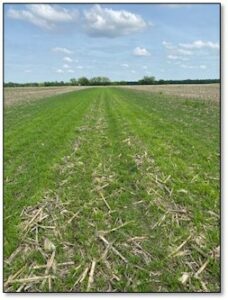
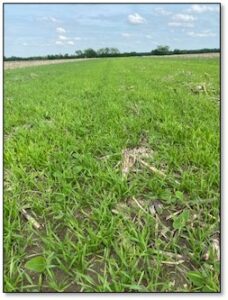
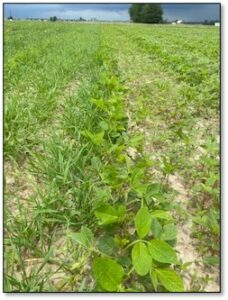
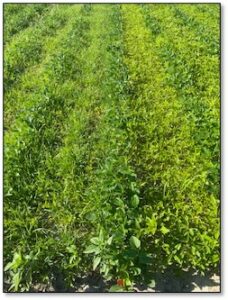
Assessment of Project Approach and Areas of Further Study. The project approach seemed appropriate to achieve the desired outcome. It was important that the grower participants took an active role in deciding how to implement the project based on their own ideas and preferences. All participants approached the project with plans that varied and were eager to try something different. As mentioned by our grower participants, areas of further study could include seeding the winter wheat early in the spring with fertilizer in a fertilizer buggy to avoid the extra task of planting the winter wheat at the time of soybean planting. Additionally, methods of planting the winter wheat and soybean at the same time without making two separate passes through the field could be investigated. Since economics was a point of concern made by all of the growers, one could do an economic analysis to determine the monetary difference between utilizing the inter-seeded winter wheat system versus the standard PRE fb POST herbicide program.
Educational & Outreach Activities
Participation Summary:
3 grower participants. Three commercial farms participated in this research.
1 published press articles, newsletters. ‘SIU Doctoral student seeks innovative, sustainable way to control aggressive weed – This is SIU’
1 Field Day presentation. ‘Integrating Inter-seeded Winter Wheat for Weed Control in Soybean.’ 83 farmers participated in this outreach activity (Figure 1.).

1 Conference poster presentation. ‘Barriers to Adoption: Farmer Collaborators Use Inter-seeded Winter Wheat Practices as a Sustainable Approach for Suppressing Common Waterhemp in Soybean’ presented at the North Central Weed Science Society meeting in Grand Rapids, MI. 2021.
1 Conference recorded oral presentation. ‘Inter-seeding Winter Wheat in Soybeans for Early Season Weed Suppression’ presented at the Weed Science Society of America virtual meeting in Vancouver, Canada 2022.
This information is being prepared for use as an educational tool and publication.
Project Outcomes
The initial outcome of this research was the testing demonstration and outreach of a novel IWM practice. Volunteer farmer cooperators were consulted on study implementation before, during, and after the project, completion to gather opinions, understanding, and future suggestions. Additionally, two grower cooperators were available to answer questions from other farmers during the project demonstration at the SIU Belleville Field Day (Figure 3.).
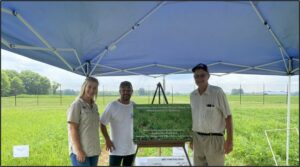
Demonstrations and presentations highlighting IWM practices help introduce the practice to regional farmers and encourage the adoption of integrated weed control strategies. Preliminary research at SIU was presented at the SIU Agronomy Research Field Day in 2019, resulting in positive remarks and articles in the Illinois Agrinews (SIU Studying Crop Based Strategy to Suppress Common Waterhemp) and Illinois Farmer Today (Under Cover: Interseeding Wheat May Help in Battle Against Resistant Weeds). We want to continue targeted communication efforts with farmers to address misinterpretations and misconceptions about integrated weed management practices. Targeted communication should highlight the cost-effectiveness and approach methods of integrated weed management to help increase its adoption, thus increasing the sustainability of the agro-ecosystem (Wilson et al. 2009). Additionally, working on a farm with growers helped promote farmer-scientist interaction, which is incredibly important for keeping agronomic science grounded in practical tactics.
When working with inter-seeded crops, it is important that you have a successful establishment to provide ground cover and active competition. All locations had a well-established winter wheat stand, likely a result of early spring planting. Adequate and timely rainfall events are vital to establishing the winter wheat, especially where the winter wheat was broadcast and not drilled. Previous research has also noted that as heat increases later in the growing season, winter wheat germination is reduced. Throughout this project, it was apparent that regardless of location and planting method, the winter wheat negatively impacted the germination and development of Amaranthus species. This research further supports previous research that inter-seeding winter wheat could be an effective integrated weed management system to use as an alternative weed control approach or to supplement current soybean herbicide programs.
Farmer Spotlight
Questions were given to each cooperator after trials were harvested in 2021. Answers were reported to me through email or phone conversation in spring 2022.
Q1.) As a grower, what barriers do you see (if any) to using alternative weed control methods?
A1.) The barriers we see on our operation for implementing alternative weed control measures are time and manpower.
A2.) The inconvenience of alternative methods such as making separate trips over the ground.
A3.) Alternatives will need to be similar or even cheaper than herbicides.
Q2.) What may help growers adopt weed control tactics that do not rely as heavily on herbicides?
A1.) Lack of availability of herbicides or lack of effective herbicides.
A2.) Making the practice convenient for the farmer to implement. The budget and the economics must be considered.
A3.) I think making alternatives cost-effective to use. I think some growers will have to be incentivized to try something different, but as herbicide resistance becomes more prevailing, I believe growers will look at all options available.
Q3.) What are your overall thoughts on the inter-seeded winter wheat practice we implemented this summer?
A1.) The system worked great. If we could find a way to seed the winter wheat and plant soybeans in the same pass at the same time it would be better.
A2.) I like the inter-seeded winter wheat practice but am not ready to adapt 100%. The cost is one thing. But the positive environmental factor of the program is nice. I want things easy, and right now spraying is easy.
Q4.) Positives and negatives of this inter-seeded wheat system?
A1.) The negative aspect is the additional trip over the ground. The positive of you letting the winter wheat come up is the addition of carbon/organic matter to the soil. It could possibly provide some erosion control.
A2.) I think the negative part of inter-seeding winter wheat is the timeliness of trying to do it in the spring while doing all other operations. It is not as fast as a burndown application using a sprayer with 100 ft booms. I like the idea of cover crops or something like this to help control weeds if it is economically feasible.
Q5.) If you were to use the inter-seeded winter wheat system, what changes would you make to the system or its implementation? Would you do anything differently if you were to run the trial again?
A1.) We would try to work out a way/method of planting the winter wheat and soybeans in a single pass at the same time.
A2.) I am currently looking at adding the wheat in with a fertilizer spreader and dropping it in November/December. Once the wheat was spread, I ran it over with a double rolling basket to slightly incorporate the wheat and crush the corn stalks down over it. Since it was so cold when the wheat was spread, I hoped it would not start to emerge until springtime before soybean planting. If I were to run the trial again like how we implemented it last summer, I would terminate the wheat a little earlier than we did. The wheat seemed to somewhat stunt the growth of the soybeans compared to the soybean-only treatments.
A3.) Great question. I am not sure there is much that can be changed. Maybe make sure that the wheat is spread evenly to get consistent coverage. I still think a residual would have to be added during burndown as our weed pressure is very high in southern Illinois.
Q6.) Do you incorporate other methods of weed control aside from herbicides on your farm operation? If so, what alternative weed control methods do you use?
A1.) Aside from herbicides, we use cover crops as an alternative measure for weed control.
A2.) Not currently other than some occasional tillage before planting.
Based on the results of this research and results of similar research performed at Southern Illinois University Carbondale, a few recommendations can be made.
First, the grower should aim to plant or drop spread the winter wheat into a clean seedbed early in the planting season, preferably early to mid-April. This allows the wheat time to emerge and establish before the onset of heavy Amaranthus emergence in the Midwest. This also helps ensure that the winter wheat receives the rainfall necessary to germinate. Seedbed preparation can include no-till, reduced-till, or conventional-till practices. If drop-spreading winter wheat, light incorporation of the seed is suggested.
Second, the grower should be mindful of when the post-emergence herbicide application needs to be applied. This generally occurred around the soybean V3-V4 growth stage. It is vital that the grower makes sure that the winter wheat is terminated at this time to avoid negatively influencing soybean growth or yield. In a dry growing season, the POST should be made at the earlier end of this spraying window (V3). Later applications could potentially reduce the effectiveness of the herbicide due to coverage issues from increased winter wheat and soybean canopy coverage.
Third, if a grower wanted to apply residual pre-emergent herbicides, these could be applied before the POST when the winter wheat was emerged and/or with the POST application. The only location to not need a second POST application to clean up spray skips / new weed emergence was the Salem IL location. This location had soybeans planted on 19 cm rows. This narrow row allows soybeans to achieve canopy coverage quicker which could aid in the reduction of new weed emergence following a POST application.







